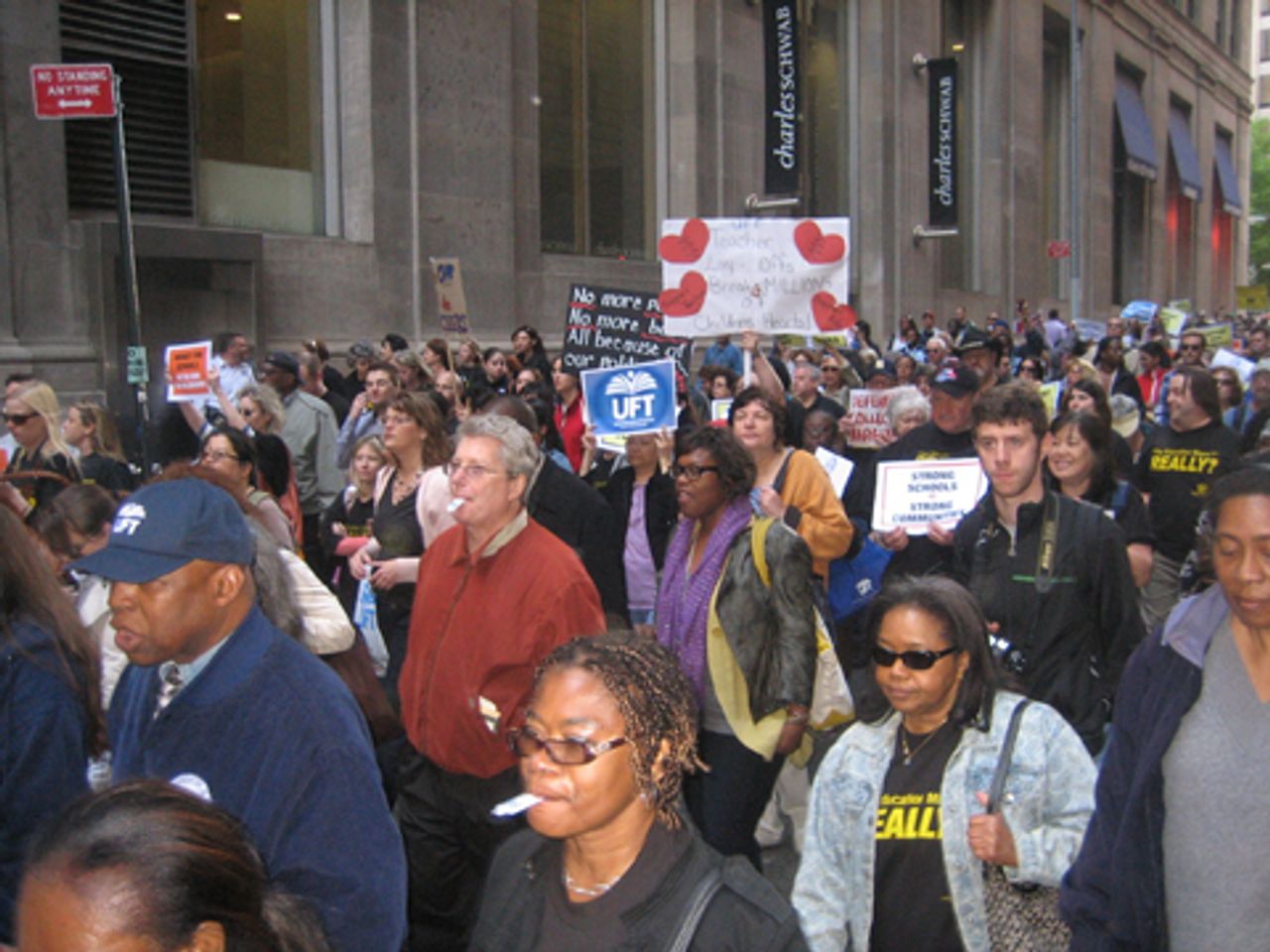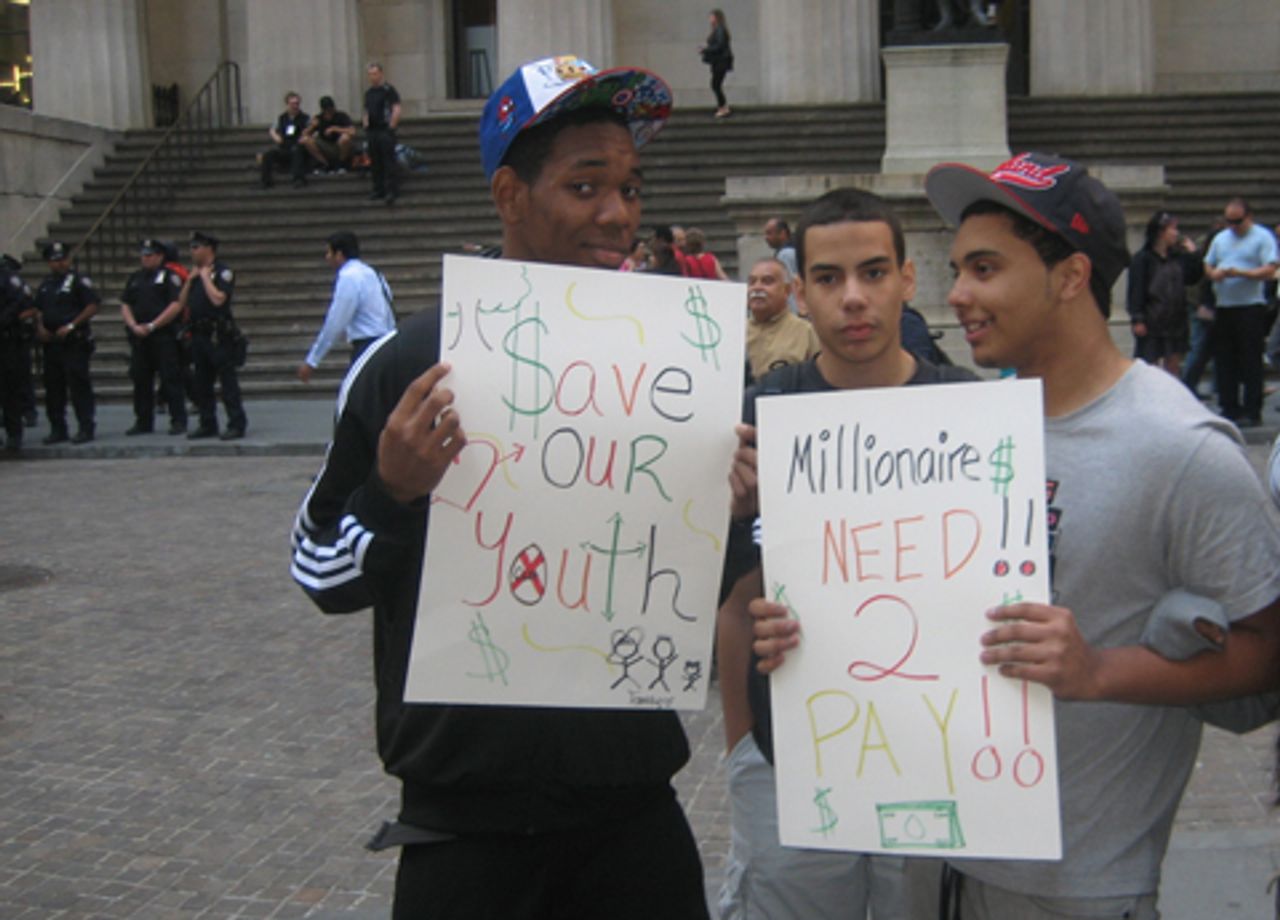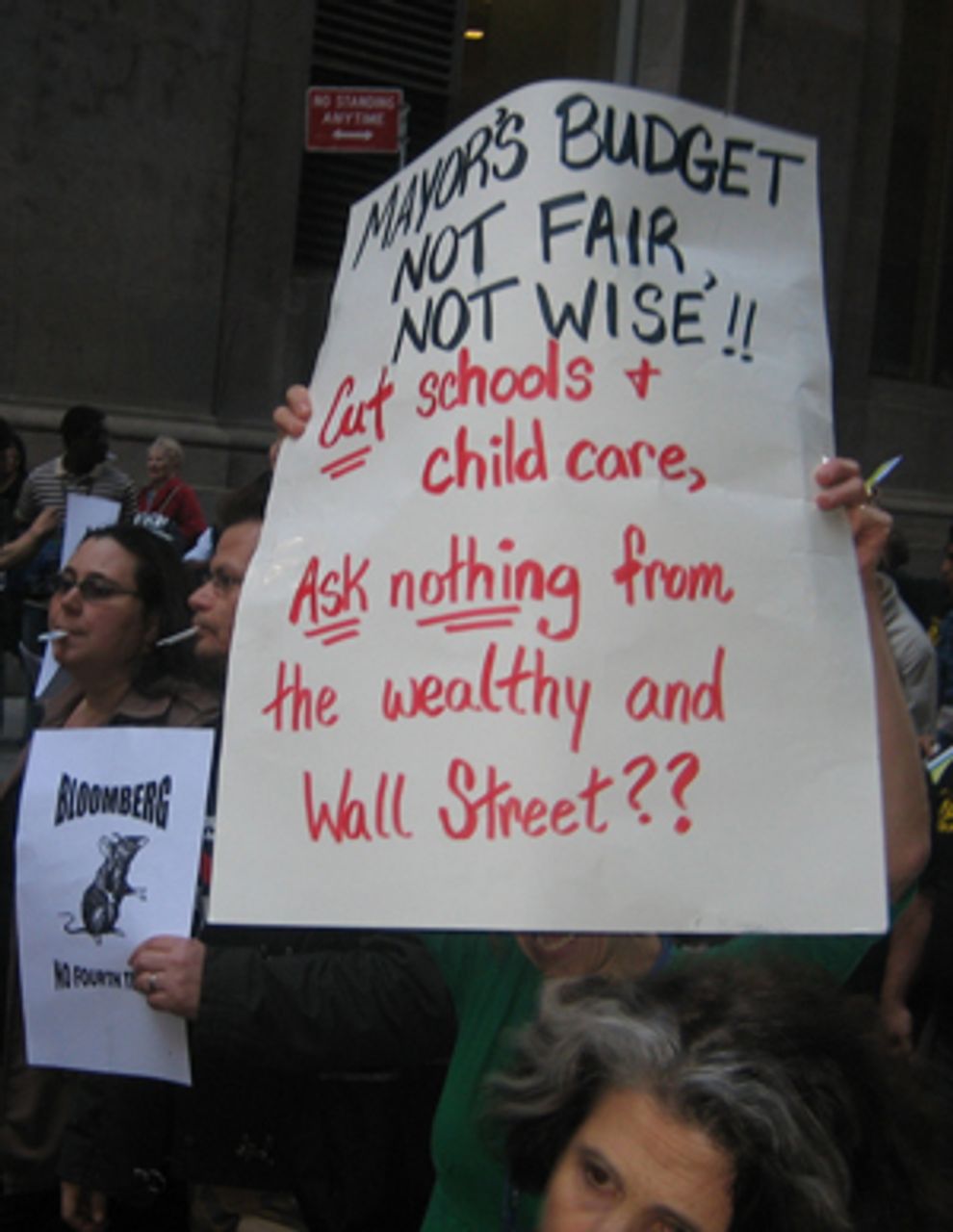Several thousand protesters marched past Wall Street and New York City’s financial district late Thursday to protest Mayor Michael Bloomberg’s $600 million in budget cuts. These cutbacks will cripple social services as well as programs for youth and the elderly, close firehouses and eliminate over 6,000 teaching jobs in the public school system.

Contingents of teachers from all five boroughs of the city—including both younger and older teachers—marched, as did other city workers and representatives of a myriad community programs whose funding will be partly or totally eliminated. One large group consisted of advocates for the city’s homeless.
Marchers carried homemade signs that expressed the mounting social anger in the working class toward the redistribution of wealth in the United States from the majority of the population to the moneyed elite. One sign read “Cut schools and child care and ask nothing from Wall St?”
Others said, “Lay off Bloomberg, Save teachers and kids.” One group of youth from Brooklyn, whose school program will be eliminated by the budget cuts, carried signs that said, “Millionaires need to pay!” Marchers chanted “JP Morgan shame on you” and “Tax the rich.”
The budget cuts will result in the layoff of over 4,000 teachers and eliminate 2,000 other teaching slots left open by retiring teachers. It will increase the sizes of already crowded classrooms and decimate after-school, arts and sports programs in elementary, middle and high schools across the city. Over a thousand other city workers will lose their jobs as well.
Programs to reduce domestic violence will be cut. Summer jobs programs for youth will provide even fewer jobs to meet the vastly increased demand from young people. Funding for homeless shelters will be cut, as will programs to help families make the transition form shelters to apartments.

The march expressed the hatred of broad layers of the city’s population for the piratical behavior of the Wall Street banks. While the unions have tried to confine previous rallies to the City Hall area, the reaction of the rank-and-file teachers and workers as well as broader layers including youth, representatives of social service agencies and advocacy groups to demonstrating in the center of financial industry was in stark contrast to the pro-Democratic Party policy of the union bureaucracy.
Increasingly, New Yorkers see the budget cuts as a part of a class policy. The criminality of Wall Street, in fact, has become the normal focus in conversations among working people throughout the city about the decline in living standards and the increasingly difficult conditions of life that millions have had to contend with since 2008. It is lost on no one that these banks took trillions of dollars from a government that now claims there is no money to support the most necessary—and often the most minimal—social needs, from education, to elder care, to housing for the homeless.
The march was organized by the May 12 Coalition, in which several trade unions, including the Communications Workers of America (CWA), the United Federation of Teachers (UFT) and the Service Employees International Union (SEIU), played the leading role. Rank-and-file members of these organizations comprised the bulk of the protesters.

The unions participated in the march not to defeat the budget cuts or to propose a course of action that could restore the funding, but to provide a safety valve to dissipate the anger and frustration that millions of New Yorkers, including their own members, feel at the gaping social inequality in the city and the assault on living standards by federal, state, and local governments from across the official political spectrum.
The strategy of the unions was to avoid any analysis of the fundamental causes of the budget cuts and blame them on the pro-banker polices of the Bloomberg administration, with no reference whatsoever to the leading role that the Democratic Party is playing in implementing budget cuts at the federal and state levels.
“It’s very simple,” United Federation of Teachers (UFT) President Michael Mulgrew told the media. “The mayor needs to make the choice to use the city’s surplus to stop playing games with the city’s future.”
Randi Weingarten, president the American Federation of Teachers and former head of New York City’s UFT, was quoted by the Huffington Post as saying in reference to the $3 billon budget surplus resulting from increased tax revenue produced by Wall Street’s super-profits, “There are lots of places across the country where there are real budget crises. New York is not one of them.”
At the podium in front of City Hall, one of the assembly points for marchers, members of the City Council’s Progressive Caucus told an audience composed primarily of teachers that “the City Council is on your side.” They denounced Bloomberg, but made no mention of Democratic Governor Andrew Cuomo’s slashing of the state budget, including funding for city schools.
Bloomberg, for his part, blamed the cuts entirely on Cuomo and said that he wished the march had gone to Albany, New York’s state capital. “If they thought we should have more money, why don’t they go up to Albany and fight for it?” he said. “We’ve been up there and we haven’t really got a lot of help.”
The May 12 Coalition produced a 32-page report documenting not only the cuts to a wide range of social programs and city agencies, but also the many tax breaks, perks and handouts by the city to some of the largest financial institutions. It concluded: “The mayor has a simple choice. He can use his power and business skills to win a fairer deal for all New Yorkers, or he can continue to let Wall Street millionaires, hedge funds and big banks roll up bigger profits, paying themselves bigger bonuses while slashing essential services and programs.”
Such statements deserve to be called what they are: groveling by bureaucratic toadies. To suggest, as the document does later, that the billionaire Michael Bloomberg, who opposed the most minuscule statewide tax of the rich, would “keep the Department of Education cuts out of the classroom” or “stop funding privately run charter schools” is simply to lie to the working people of New York City.
The budget cuts are being carried out as a means of forcing working people to pay for the economic crisis created by Wall Street. This is a consensus policy supported not just by Bloomberg, but by the entire financial elite and both its political parties.
A genuine struggle against these cuts must begin with a categorical rejection of this policy and the determination to defend jobs, education, health care and other essential social services as basic rights of the working class.
The organizations that organized such a march on the policy of “Beg Bloomberg” and issued such a report are determined to subordinate any protests over the budget cuts to their own reactionary alliance with the Democratic Party, which bears responsibility for carrying them out.
Working people must break free from these organizations and organize their own rank-and-file committees and neighborhood action groups that will mount a serious struggle against capitalism and its representatives in the Democratic and Republican parties. This is the program that the Socialist Equality Party fights for.
